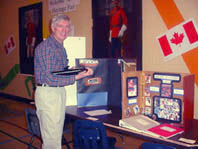
SSNS Home > Middle Years > Heritage Fairs > Cranberry Portage 2004
The Cranberry Portage Heritage Fair
20 April 2004
By Raymond Shirritt-Beaumont
For the casual passer-by, Cranberry Portage is only a momentary respite from the miles of wilderness along the No. 10 Highway north of The Pas, Manitoba. It's a small, out-of-the-way spot easily seen as a place where nothing particularly interesting happens, but if one is willing to put his biases aside and turn off the road, he is in for a pleasant surprise. That was certainly my experience on Tuesday, April 20, when I drove up from The Pas to attend the heritage fair at Cranberry Portage Elementary. It was an uneventful trip, with only an occasional spruce grouse or a passing truck to let me know I wasn't alone; however, when I arrived at the school, I opened the door to a buzz of sound and laughter, hustle and bustle, life and learning.
 |
Mr. Shirritt-Beaumont browses the project displays at the Cranberry Portage Heritage Fair. |
This atmosphere doesn't happen by accident. It takes a conscientious principal and a dedicated staff to develop a positive culture where students can thrive. I felt it from the moment I entered the school. It was evident in the display case in the foyer that celebrated student achievement, the profusion of well-cared for plants that decorated the entry, in the smile of the receptionist Kelly Armstrong, and the warm welcome of the principal Cathy Fidierchuk. From that beginning, it just got better. I met Jade Campbell for the first time. She is the gifted young artist whose prize soapstone carving I had purchased in February at the juried art exhibit held in conjunction with the annual school committee conference. It was wonderful to be able to thank her in person. The next highlight was walking into the gymnasium and seeing for the first time the tremendous work the students had done. It wasn't just show either. As I studied the projects more closely, I found depth there. These students had become immersed in their research.
It is impossible in limited space to comment on everything that I saw, but a few examples will illustrate just how good this fair was. the Grade One/Two Class researched to find out their grandparents' places of origin, then mapped the information with strings radiating out from Cranberry Portage to the many countries involved. Conner Ashton, who was dressed in formal RCMP attire, and Natazsa Johnston ably answered any questions I asked them about their discoveries. Catlin Carriere did a great job of celebrating the life of Roger Carriere, who was King Trapper twenty-five times at The Pas Trappers' Festival. On inquiry, I learned that she was very proud of this grandfather whose history was unknown to her before.
 |
 |
Conner Ashton (dressed in an
RCMP uniform) |
Caitlin Carriere's project on
her grandfather, King Trapper Roger Carriere. |
Connie Cook did a similar project on her grandfather Walter Cook, who discovered the most northern nesting site of the endangered piping plover. He also proved that Grand Rapids bats don't migrate, but spend their winters in nearby limestone caves. Vanessa Petznick's "Quilts and Quilting" included interviews with family members, samples of family quilts, and her own quilting efforts to tell the story of several generations of quilt-making in her family.
 |
Connie Cook's project on her grandfather, Walter Cook. |
Ashley Tie dressed in traditional aboriginal dress to complement her project "Women of the Fur Trade," which included a biography of Margaret Taylor, ancestor to Shirley Hogue, a former Language Arts Consultant in Frontier School Division. Chelsea Fosseneuve investigated her Metis roots in a well thought out project, which included a draw for a Metis sash!
 |
Ashley Tie dressed in traditional aboriginal dress to complement her project "Women of the Fur Trade." |
Of all the students I interviewed, perhaps the most enthusiastic and knowledgeable were Ryan Rajczakowski and Jesse Soshychki, who knew everything there was to know about World War II equipment and weaponry. In a visit I had later in the day with Ryan's grandmother, local historian Mary Ann Playford, I learned that he came by his interest naturally, as his grandfather is keenly interested in World War II paraphernalia. There were also several projects that included PowerPoint presentations, like that of Nicholas Kosmenko, who focused on Canadian Hockey heroes of today and yesterday. And much much more.
 |
 |
Ryan Rajczakowski and Jesse Sochychki knew everything there was to know about WWII equipment and weaponry. |
Nicholas Kosmenko's PowerPoint presentation focused on Canadian hockey heroes of today and yesterday. |
Since the projects were on display during the day, parents and other interested community members had a chance to drop in and view their children's work. Local judges also assessed the projects and talked to the students, who were honoured at the end of the fair in a special programme organised by the staff. Most of the students were recognised in some way, and I thought it appropriate that they were able to choose their own book prizes. It was a great day. After the fair was over, I drove away feeling very privileged. I had participated in a wonderful event that was a combination of excellent staff organisation, student achievement, and community good will. It was no last-minute, two-week frenzy, but the culmination of several months of day-by-day, consistent preparation that left its organisers exhilarated and still smiling after a full day's celebration. It was just what a heritage fair should be.